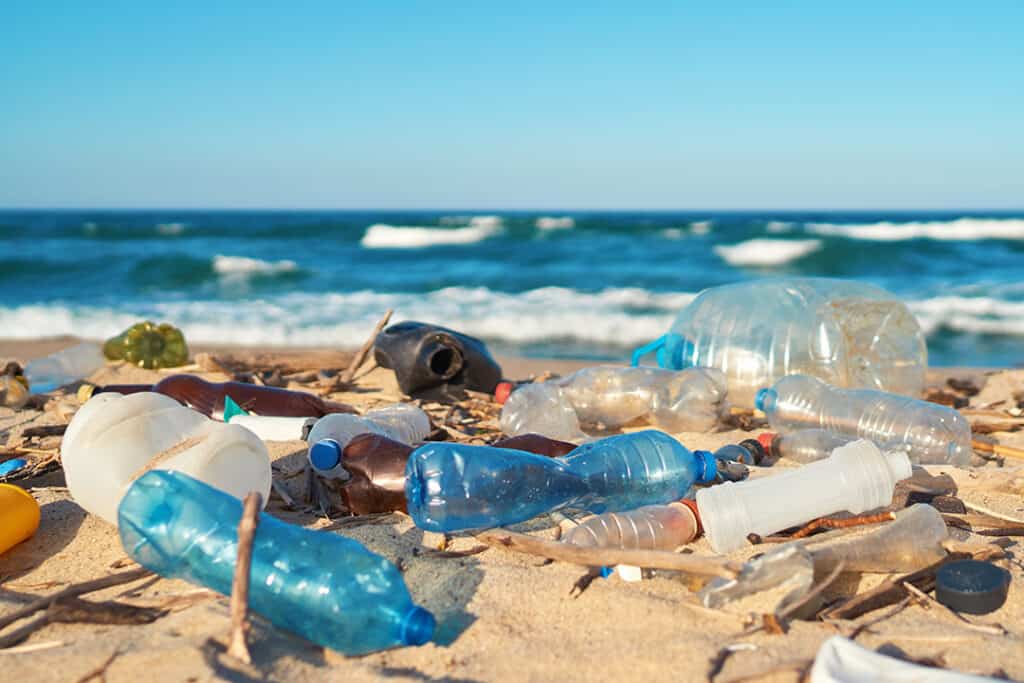For More Environmentally Friendly Options
Summertime is a wonderful time to soak up the sun and have fun swimming at the beach, bike riding, walking on nature trails and enjoying the outdoors. This is the perfect time to take in the gifts that our environment has to offer. The Hamptons is particularly rich in this category with our gorgeous beaches and luscious landscapes. In this moment we should be reflecting on these gifts and think about ways to protect them. One way to do that is to decrease our dependence on single-use plastics. Every plastic water bottle, or single-use plastic fork, or plastic bag has an impact on our environment, our wildlife, and our bodies.

13 million tons of plastic ends up in rivers, lakes, and the ocean every year, and are both consumed by sea life and birds and micronized in our waterways. This does significant harm both to our wildlife and to our food supply. The micronized plastics are small enough to be eaten by plankton, which then make their way up the food chain to us. Microplastics are found not only in fish, but in beer, honey, sea salt, and of course, bottled water. In fact, in 2017, Orb Media found that 93% of popular US water brands tested contained up to 10,000 microplastic particles per liter.
Plasticizers are another problem. These are chemicals like BPA and phthalates which are added to plastics to make them softer, more pliable, and translucent. These chemicals leach into our water, food, particularly when plastics are exposed to sunlight and heat. Plasticizers are endocrine-disrupting chemicals (EDCs). EDCs can block, mimic, and disrupt normal hormone signals. When the plastics, heat up, or micronize, these endocrine disrupters are released into our environment, and our water ways. When these chemicals are ingested, they can create misinformation in the body which can lead to health conditions like obesity, diabetes, chromosomal abnormalities, cognitive issues, fertility issues, breast and prostate cancer. Our genetics and detoxification pathways have not evolved to manage microplastics and plasticizers. And we still don’t know all the health consequences.
So, what can we do? The answer, use fewer plastic products. Make your dollars make a difference by purchasing environmentally friendly version of products.
1. Choose products that are packaged in sustainable materials. For example, purchase eggs that are packaged in egg cartons, and not ones packaged in plastic.
2. Use glass containers for storing your food at home. Mason jars and other glass storage containers will both reduce the plastic in the environment and reduce your exposure to endocrine disrupting chemicals.
3. Lost your lids? Instead of using plastic wrap use reusable silicone or beeswax wraps.
4. Instead of plastic ziplock bags or takeout containers, use sustainable reusable lunchboxes with reusable containers, beeswax wraps for sandwiches and bamboo cutlery.
5. Use reusable cutlery. In our office at STANDwellness we have cutlery that we wash and use again. We do this instead of each of us using a plastic fork every day to eat our lunch. This adds up to keeping about 1,040 forks out of landfills and waterways per year. And this is just for our office!
The point here is to be aware, and to make choices that put the environment first. These choices will require a change of habit for all of us. As Buddha said, “Each morning we’re born again. What we do today is what matters most.”







![Previously featured on our 2024 Columbus Day issue cover, 74 Meeting House Road has officially sold! This stunning new construction in Westhampton Beach offers the perfect blend of thoughtful design and timeless style. Congratulations to @kimberlycammarata of @douglaselliman who held the listing! [link in bio]](https://hamptonsrealestateshowcase.com/wp-content/uploads/sb-instagram-feed-images/491441951_18504901357030135_2664904795600183799_nfull.webp)
![Located South of the highway in Southampton this 4 bedroom, 5.5 bath multi-story property, offers extensive exterior architectural detail throughout. 60 Middle Pond Road offers breathtaking views and tranquil living, nestled along the serene shores of Middle Pond and Shinnecock bay. Represented by @terrythompsonrealtor @douglaselliman. [link in bio]](https://hamptonsrealestateshowcase.com/wp-content/uploads/sb-instagram-feed-images/491451873_18504686110030135_5284427082339135969_nfull.webp)
![Introducing a rare opportunity in the heart of East Hampton Village South: 18 Egypt Close. This exquisite property was meticulously renovated a decade ago, nestled on a lush builders’ acre, blending modern luxury with timeless elegance. Represented by The Hamptons Group of @thecorcorangroup. [link in bio]](https://hamptonsrealestateshowcase.com/wp-content/uploads/sb-instagram-feed-images/491439291_18504471214030135_4957995907041134776_nfull.webp)
![Once the temporary home of architectural legend Frank Lloyd Wright—who lived here while designing the Guggenheim Museum—this extraordinary corner residence at 1 Central Park South transcends the typical Manhattan luxury offering. This 4,000± sq. ft. masterpiece within the Plaza Hotel has returned to market asking $18.9M. [link in bio]](https://hamptonsrealestateshowcase.com/wp-content/uploads/sb-instagram-feed-images/490259326_18504258406030135_5203375842768220403_nfull.webp)
![Chef and bakery owner Karoline Cerqueira has Hamptonites hooked on her dreamy confections, flaky croissants, fruit tarts, and pies that taste like grandma made ‘em. Filled with golden light and the warm scent of fresh baking goodies, @windmilllanebakery provides the perfect backdrop for this pretty Easter tablescape designed by @kdhamptons. [link in bio]](https://hamptonsrealestateshowcase.com/wp-content/uploads/sb-instagram-feed-images/490362407_18503819719030135_8660900959925874834_nfull.webp)

![Situated on Atlantic Avenue and just two blocks from the beach, The Seagate in DelRay opened its doors in 2009, and like the area around it, the luxury hotel has recently debuted some impressive changes. Inside the hotel, all 157 guest rooms and suites have been renovated from top to bottom while amenities include upscale dining, a beach club, golf course, pickleball courts, spa, pool, and private beach access. [link in bio]](https://hamptonsrealestateshowcase.com/wp-content/uploads/sb-instagram-feed-images/488990822_18503394892030135_7274019688908843053_nfull.webp)
![Just completed and crafted to perfection, 5 Widow Coopers Path boasts 9,692± sq. ft. of luxury living with high-end finish, linear lighting, custom cabinetry, and a keen attention to detail throughout. This sleek open floor plan boasts a sun-filled reception and open floor plan that seamlessly flows through the gallery into the living space. Represented by @jameskpeyton of @thecorcorangroup. [link in bio]](https://hamptonsrealestateshowcase.com/wp-content/uploads/sb-instagram-feed-images/490370207_18503184790030135_3640167241276553057_nfull.webp)
